Post contributed by Dr. Sandro Rossato, Department of Geosciences, University of Padova, Padova, Italy
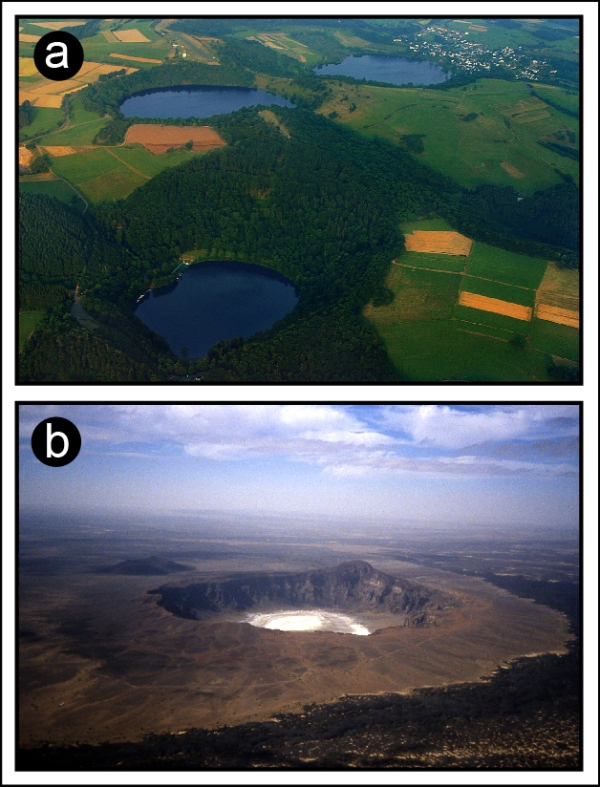
Figure 1: Terrestrial maars. (a) is a group of three maars filled with water in the Eifel region, Germany (rim-to-rim diameter ~0.5-1 km) (“Maare” by Martin Schildgen – Own work. Licensed under CC BY-SA 3.0 via Wikimedia Commons – https://commons.wikimedia.org/wiki/File:Maare.jpg#/media/File:Maare.jpg). (b) shows the Wabah maar, located in Saudi Arabia (rim-to-rim diameter ~2 km) (courtesy of Vic Camp, San Diego State University).
Terrestrial maar-diatremes are small volcanoes (see this previous post for a general description) which have craters whose floor lies below the pre-eruptive surface and are surrounded by a tuff ejecta ring 2-5 km wide (Figure 1) that depends on the size of the maar itself and on the depth of the explosion (Lorenz, 2003). Maar-diatremes constitute highly valuable sites for in situ investigations on planetary bodies, because they expose rocks at the surface from a great range of crustal depths and are sites which could preferentially preserve biomarkers.
The explosive eruptions that produce Maar-diatremes can penetrate down to at least 2.2 km (Valentine, 2012), meaning that material deriving from different depths in the crust can be analyzed and sampled quite easily by a rover at the surface, having been exposed and fragmented. Secondly, but more importantly in the search for signs of life, many maar-diatreme structures on Earth host, or have hosted long-lived lakes (White & Ross, 2011), due to their interaction with watery environments and to the elevation of the crater floor, often below the groundwater table. Post-eruptive lacustrine sediments are commonly found on Earth inside the crater, in some cases hosting invaluable fossil records (e.g. the Messel pit UNESCO fossil site, Germany; Figure 2).
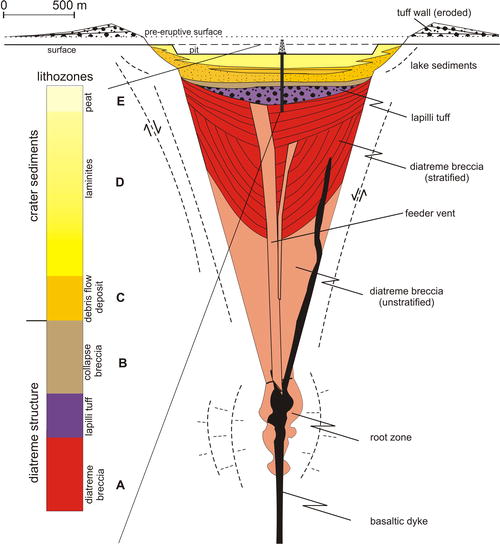
Figure 2: A diagram of the maar-diatreme structure of the Messel pit fossils site, Germany (Schulz et al., 2005). This quarry hosts the richest site on Earth for the living environment of Eocene (0.57–0.37 Gy ago).
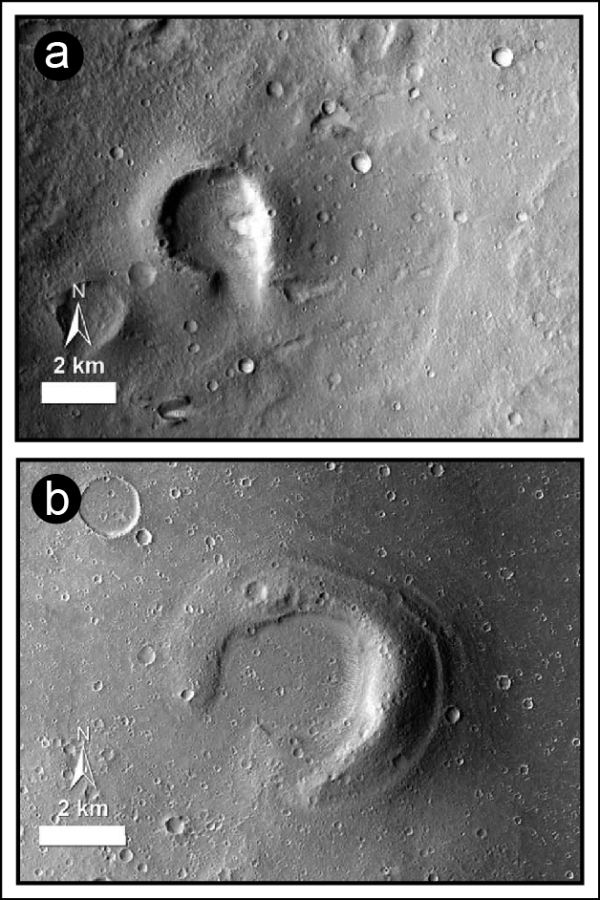
Figure 3: Martian pitted cones which have been interpreted as due to hydrovolcanism, located in the Nephentes/Amenthes region (southern margin of Utopia Planitia; Brož and Hauber, 2013). Images are CTX, in particular P17_007489_1967 (a) and a mosaic of B19_017075_1974 and G01_018776_1974 (b).
On Mars examples of hydrovolcanism have been reported (e.g. Keszthelyi et al., 2010) but only in rare cases they have been ascribed to a maar-diatreme structure (e.g. in the Nephentes/Amenthes region, on the southern margin of Utopia Planitia; Figure 3). Maar-diatreme structures usually derive from multiple blasts that may alter the morphology of the landform, making its identification more demanding.
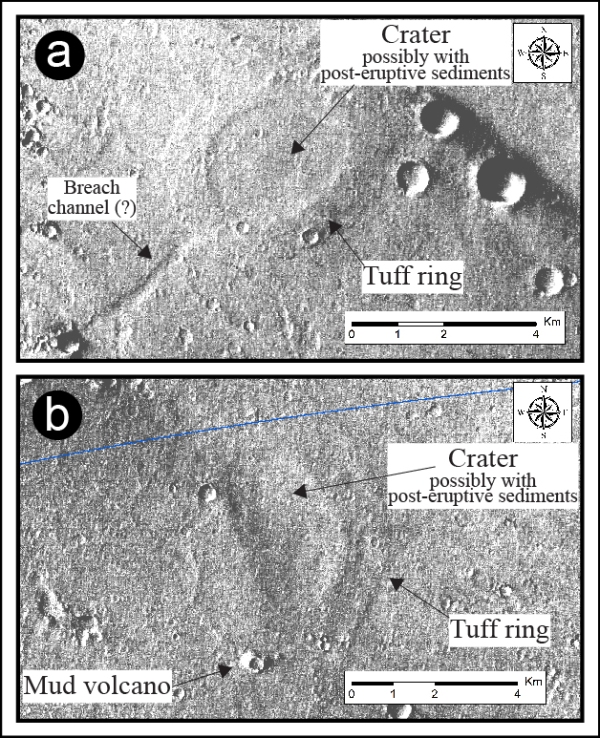
Figure 4: Two close-ups (stretched HRSC image H2024_0001_ND3) of the Simud Vallis maars are presented (Pajola et al., 2016). It is possible to appreciate the high similarity with terrestrial (Fig. 1) and other Martian (Fig. 3) maars, even if the latter have greater relief.
On the contrary, those recently found in the Simud Vallis area (southern margin of Chryse Planitia; Figure 4) are morphologically very similar to terrestrial analogs, presenting rounded to sub-rounded shapes and intact tuff rings with low inclination. By means of comparisons with laboratory experiments (Figure 5), the Simud Vallis maar-diatremes are expected to have originated from one, or at maximum two, blasts which occurred at the optimal depth for maximizing the size of the craters and the distinctiveness of the morphologies.
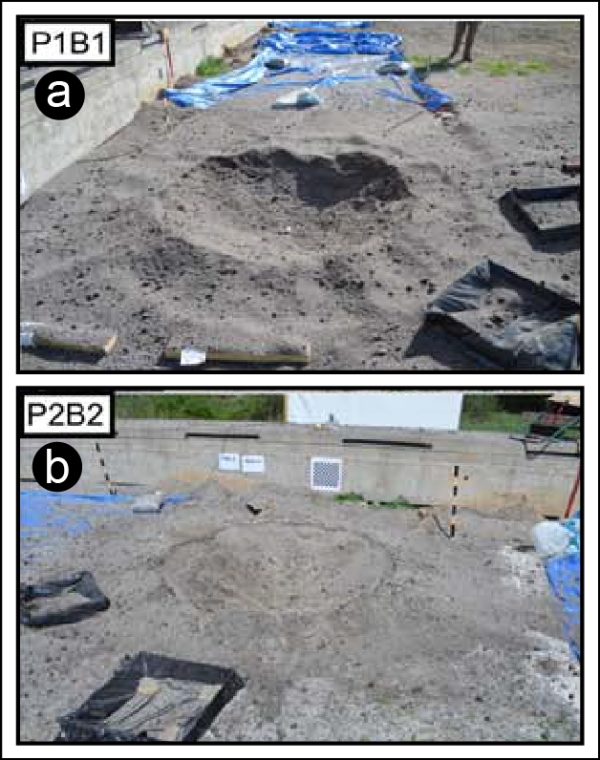
Figure 5: Scaled experiments (craters approximately 2 meters wide) reproducing the subsurface phreatomagmatic explosion (Graettinger et al., 2014). (a) shows the effect of a single blast, whilst (b) shows the result deriving from an explosion occurred under an existing crater.
Further reading:
Brož, P., Hauber, E. (2013). Hydrovolcanic tuff rings and cones as indicators for phreatomagmatic explosive eruptions on Mars. Journal of Geophysical Research E: Planets, 118 (8), pp. 1656-1675.
Graettinger, A.H., Valentine, G.A., Sonder, I., Ross, P.-S., White, J.D.L., Taddeucci, J. (2014). Maar-diatreme geometry and deposits: Subsurface blast experiments with variable explosion depth. Geochemistry, Geophysics, Geosystems, 15 (3), pp. 740-764.
Lorenz, V. (2003). Maar-Diatreme Volcanoes, their Formation, and their Setting in Hard-rock or Soft-rock Environments. Geolines, 15, pp. 72-83.
Keszthelyi, L.P., Jaeger, W.L., Dundas, C.M., Martínez-Alonso, S., McEwen, A.S., Milazzo, M.P. (2010). Hydrovolcanic features on Mars: Preliminary observations from the first Mars year of HiRISE imaging. Icarus 205, pp. 211-229.
Pajola, M., Rossato, S., Baratti, E., Mangili, C., Mancarella, F., McBride, K., Coradini, M. (2016). The Simud-Tiu Valles hydrologic system: A multidisciplinary study of a possible site for future Mars on-site exploration. Icarus, 268, pp. 355-381.
Schulz, R., Buness, H., Gabriel, G., Pucher, R., Rolf, C., Wiederhold, H., Wonik, T. (2005). Detailed investigation of preserved maar structures by combined geophysical surveys. Bulletin of Volcanology, 68 (2), pp. 95-106.
Valentine, G.A. (2012). Shallow plumbing systems for small-volume basaltic volcanoes, 2: Evidence from crustal xenoliths at scoria cones and maars. Journal of Volcanology and Geothermal Research, 223-224, pp. 47-63.
White, J.D.L., Ross, P.S. (2011). Maar-diatreme volcanoes: A review. Journal of Volcanology and Geothermal Research, 201 (1-4), pp. 1-29.



